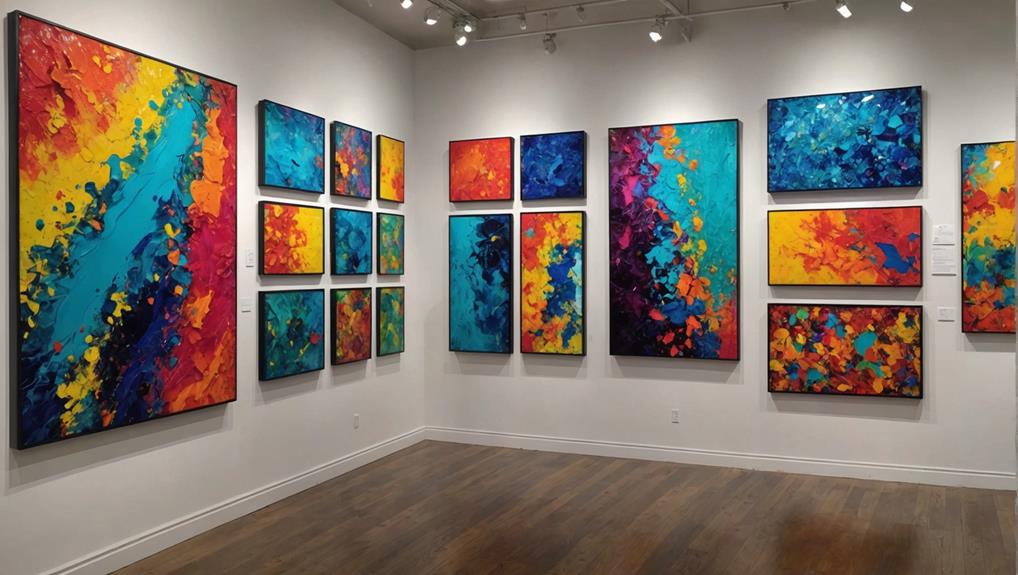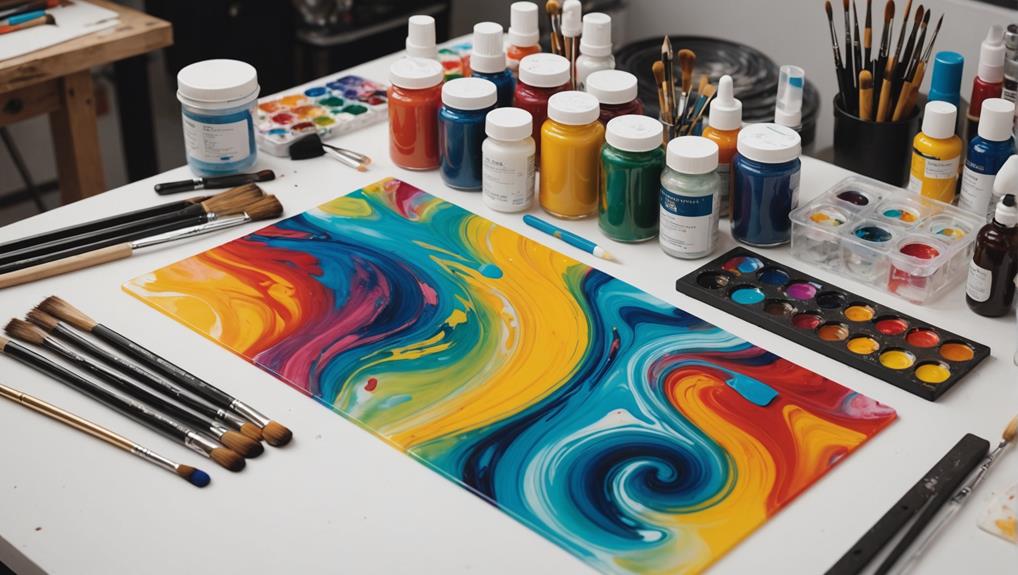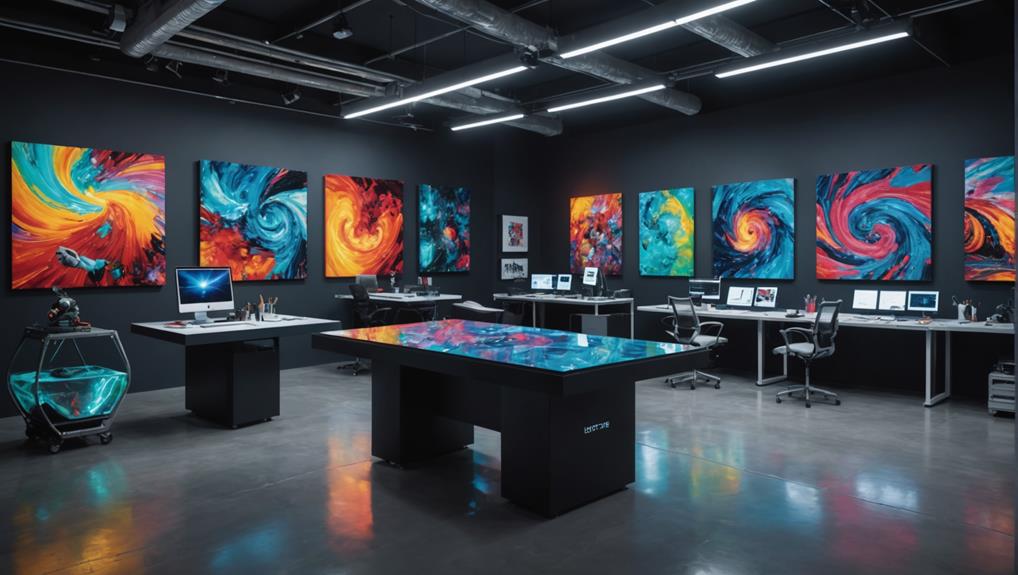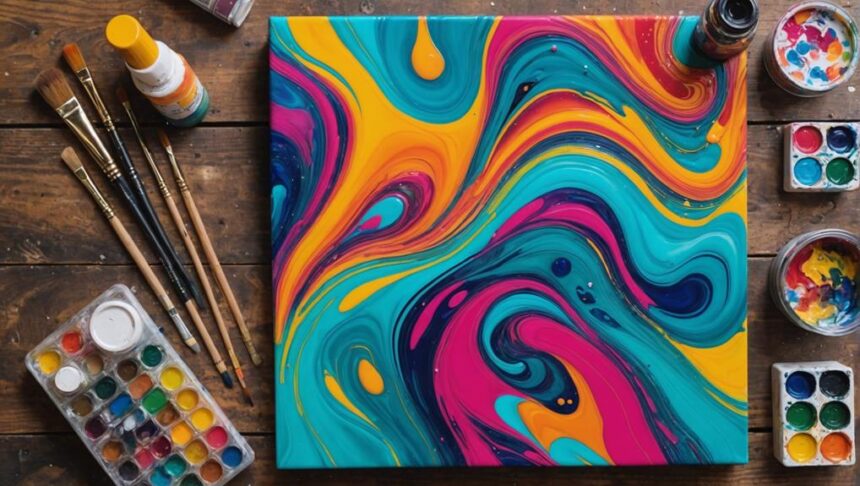Acrylic resin art got its start in the 1930s when clever chemists in Germany whipped up this versatile material. People first used it for things like coatings and adhesives. But soon, artists like Diego Rivera realized its quick-drying and durable nature made it perfect for their massive murals. By the 1950s, the secret was out, and artists everywhere, including famous ones like David Hockney, were hooked. Acrylics became a game-changer, thanks to their bright colors and ease of use. Curious how this shifted into the vibrant scene of pop art and beyond? There’s a colorful story to uncover!
Key Takeaways
- Acrylic resin art began in the 1930s with chemist Otto Rühm creating the first usable form of acrylic resin.
- Initially developed for commercial uses, acrylic resin was later adopted by artists for its quick-drying and durable properties.
- Diego Rivera’s use of acrylic paints for murals in the 1940s highlighted their artistic potential.
- The post-World War II era saw increased popularity of acrylics in fine arts due to advancements in chemistry.
Origins of Acrylic Resin
The origins of acrylic resin trace back to the 1930s in Germany, where it was first developed as an innovative medium. Imagine the excitement in the air as chemists tinkered with different chemical properties to create something completely new! They were like modern-day wizards, combining ingredients in unique ways to produce acrylic resin. This wasn’t just any old concoction; it had the potential to change the art world forever.
The magic began with the formulation processes. These chemists had to carefully balance various compounds to achieve the perfect mix. Acrylic resin had to be durable, flexible, and easy to apply. They experimented with different chemical properties, like how the resin reacted with other substances and how it dried. This was no easy feat, but their hard work paid off.
Development in the 1930s
During the 1930s, the development of acrylic resin marked a significant milestone in the evolution of artistic mediums. It all began with some serious German innovation. Chemist Otto Rühm made a breakthrough with acrylic chemistry, creating the first usable form of acrylic resin. Imagine being a chemist and suddenly realizing you’ve made something entirely new! Rühm’s work led to advancements in water-based paints, which was a pretty big deal back then.
Then came BASF, another German company, which took Rühm’s discovery and ran with it. In 1934, they introduced the first usable acrylic dispersion. This was like the original version of the acrylic paints that people are familiar with today. At first, these early acrylics were meant for commercial uses, like coatings and adhesives. Nobody was thinking about art—yet.
But here’s the kicker: these developments in the 1930s set the stage for something much bigger. Artists in the ’40s and ’50s would later discover the amazing versatility and quick-drying properties of acrylic resin. The groundwork was laid, and soon enough, the art world would never be the same. Pretty cool, right?
Early Uses in Art
Acrylic resin art started gaining attention in the late 1940s when artists found that water-based acrylic paints dried faster than oil paints, making them super handy for big projects.
Diego Rivera, a famous muralist, loved how durable and versatile these paints were for his massive works.
Commercial Applications Emergence
Emerging in the 1930s, acrylic resin initially found its footing in commercial applications such as signage and advertising, setting the stage for its eventual embrace by the art world. Companies used creative advertising strategies to highlight the durability and vibrant colors of acrylics, which made them perfect for eye-catching signs and billboards.
These early uses showed just how versatile and practical acrylic resin could be. As businesses saw the benefits, they started to experiment more. They even collaborated with artists to create unique, attention-grabbing displays.
Imagine walking down a busy street and being stopped in your tracks by a brightly colored sign that seemed to jump out at you—that’s the power of acrylic resin!
Artistic Adoption Milestones
The adoption of acrylic resin in the art world marked a transformative period, beginning in the 1940s and 1950s when water-based acrylic paints were introduced to artists, offering unprecedented flexibility and efficiency.
This was a game-changer. Imagine being able to manipulate paint easily and not having to wait forever for it to dry—that’s what acrylics brought to the table.
Artists were thrilled by this new medium. They could experiment in ways they never had before. This opened doors for creative minds like David Hockney and Bridget Riley, who became pioneers of acrylic usage in the 1960s. They showcased its versatility and vibrant colors, making everyone sit up and take notice.
The evolution of this medium was also driven by companies like Liquitex, which emerged in the 1950s. They marketed acrylics as revolutionary, and they weren’t kidding! Acrylics dried faster and were easier to use compared to traditional oils and watercolors.
This shift was largely due to advancements in chemistry post-World War II, making acrylics more widely accepted in the fine arts community.
Post-War Popularity
After World War II, acrylic resin paint really took off, becoming a favorite among artists for its quick drying time and versatility.
Companies like Liquitex, which started in the 1950s, were key in promoting acrylics, helping them gain traction in both commercial and fine art circles.
Influential artists like David Hockney and Bridget Riley showcased how acrylics could mimic other mediums, making them a big hit in the art world.
Commercial to Fine Art
Shifting from commercial applications, acrylic resin gained prominence in the fine art world following World War II, revolutionizing artistic techniques and materials. Initially used for industrial purposes, acrylic resin’s leap to fine art opened up a world of new possibilities. The change wasn’t just about changing tools; it was an artistic shift that redefined how artists approached their work.
In the 1940s and 1950s, companies like Liquitex started producing water-based acrylic paints. These paints were a game-changer. They dried quickly, were easy to clean, and came in vibrant colors. Artists like David Hockney and Bridget Riley quickly saw the potential. They embraced this new medium, using it to create works that were bold and bright.
One of the biggest reasons for acrylic’s rise in popularity was its non-toxic nature. Unlike oil paints, which could be pretty smelly and hard to clean, acrylics were user-friendly. This allowed artists to be more spontaneous and experimental. By the 1960s, acrylics had become a favorite among many contemporary artists, setting the stage for the explosive creativity that would follow in the Pop Art movement.
Influential Pop Art Pioneers
Acrylic resin’s post-war popularity was greatly boosted by influential Pop Art pioneers like Andy Warhol and Roy Lichtenstein, who harnessed the medium’s vibrant and versatile properties to create iconic artworks.
After World War II, artists were looking for new ways to express themselves, and acrylic paint was perfect for this. It dried quickly, allowing artists to layer colors and experiment with mixed media. This made their work dynamic and exciting.
Andy Warhol used acrylics to create bold, colorful pieces that captured the spirit of consumer culture and mass media. His famous Campbell’s Soup Cans and Marilyn Monroe portraits are perfect examples. The bright colors and sharp lines of acrylic paint helped bring his ideas to life in a way that no other medium could.
Roy Lichtenstein, another Pop Art legend, made comic strip-style artworks using acrylics. His paintings, like ‘Whaam!’ and ‘Drowning Girl,’ are full of dramatic dots and bold colors. Acrylic paint’s versatility allowed him to mimic the look of printed comics while adding his own artistic twist.
Acrylic’s Cultural Integration
Building on the momentum generated by Pop Art pioneers like Andy Warhol and Roy Lichtenstein, the post-war era witnessed acrylic paints becoming a staple in the art world due to their versatility and rapid drying properties. This period saw artists like David Hockney and Bridget Riley using acrylics to push boundaries, creating vibrant, modern pieces that spoke to the cultural significance of the times. Acrylics didn’t just stay on canvas; they became a symbol of artistic evolution, appearing in murals and street art that voiced social and political messages.
Acrylic paints quickly moved from commercial uses to fine arts, thanks to companies like Liquitex who marketed them to professional artists. Their non-toxic nature and easy cleanup made them a favorite in schools and community projects, making art accessible to more people. The medium’s flexibility allowed artists to explore new techniques and ideas, adding depth to their work and making it resonate with a broader audience.
Here’s a look at the impact of acrylics:
| Emotion Evoked | Example | Medium Used |
|---|---|---|
| Joy | Bright murals in schools | Acrylic paint |
| Resistance | Protest street art | Acrylic paint |
| Innovation | Avant-garde gallery pieces | Acrylic paint |
Acrylics became a way for artists to connect with their communities, enriching cultural landscapes everywhere.
Key Artists and Innovators

Pioneering figures such as David Hockney and Bridget Riley have considerably contributed to the evolution of acrylic resin art, demonstrating its dynamic range and vibrant capabilities in the mid-20th century. These pioneering artists showed the world how versatile and colorful acrylics could be, opening the door for many others.
However, it wasn’t just the artists who made this possible. Innovative chemists like Leonard Bocour and Sam Golden were pivotal in developing the first usable acrylic emulsions for artists between 1946 and 1949. Their work led to the commercial production of acrylic paints, making it easier for artists to access and experiment with this new medium.
Diego Rivera, known for his grand murals, adopted acrylics in the 1930s, recognizing their durability and perfect fit for large-scale works. In the UK, Lancelot Ribeiro played a significant role in popularizing acrylics during the 1960s, influencing many artists to embrace this exciting medium.
This collaboration between artists and chemists has continuously evolved, refining acrylic formulations and expanding their applications. Thanks to these key figures, acrylic resin art has become a vibrant and enduring part of the art world.
Technical Advancements
With the development of acrylic resin dispersion in Germany during the 1930s, the foundation for modern acrylic paint was established, setting the stage for considerable technical advancements in the medium.
This breakthrough led to the creation of water-based acrylic paints in the 1940s and 1950s, offering artists a safer and more versatile alternative to traditional oil paints. Liquitex began marketing these innovative acrylics to professional artists in the 1950s, which considerably boosted their popularity.
Technological advancements in acrylic formulations have been remarkable. Chemists and artists have collaborated to refine the paint’s consistency, durability, and color range.
These formulation innovations have resulted in a variety of textures and finishes, enhancing the versatility of acrylic paint for artistic expression. Artists can now choose from glossy, matte, or even textured finishes, allowing for greater creativity and experimentation in their work.
The texture diversity offered by modern acrylics has opened up new possibilities for artists, enabling them to create works with unique tactile qualities.
This flexibility has further cemented acrylic paint’s place in contemporary art practices, making it a favorite among artists seeking both reliability and creative freedom.
Acrylic Techniques

The advancements in acrylic formulations have directly contributed to the development of a wide array of techniques such as pouring, glazing, and impasto, allowing artists to achieve diverse visual effects and textures. Acrylic paint dries quickly, so artists can layer fast, creating textures and effects without waiting forever for paint to dry. Imagine painting a second layer without smudging the first one!
Pouring techniques are super popular. You mix acrylic paint with a medium to make it flow, then pour it onto the canvas. Sometimes, artists add silicone to create “cells,” which look like tiny bubbles or circles. It’s a bit like magic!
Glazing methods are another cool trick. You use thin layers of transparent paint to create depth and vibrant colors. This method can make your artwork look like it’s glowing from within.
Here’s a quick look at these techniques:
| Technique | Description |
|---|---|
| Pouring | Mixing paint and medium, then pouring onto canvas |
| Glazing | Applying thin, transparent layers |
| Impasto | Thick paint application for texture |
| Mixed Media | Combining acrylics with other materials |
Acrylics are also fun with mixed media. You can add bits of paper, fabric, or even sand. So, there’s no limit to what you can create!
Societal Impact
Acrylic resin art emerged as a significant medium during the post-World War II era, reflecting societal changes and the shift towards contemporary art forms. This period saw a boom in creativity, with artists exploring new ways to express themselves and connect with their communities.
One of the biggest impacts of acrylic resin art has been its role in community engagement. The materials are easy to use and accessible, which means more people can get involved in making art. This has led to amazing public art projects where entire neighborhoods come together to create something beautiful.
Acrylic resin art has also been a powerful tool for cultural commentary. Artists like Andy Warhol and Roy Lichtenstein used acrylics to talk about big issues in society, like politics and consumerism. These artworks make people think and start important conversations.
The non-toxic nature of acrylics has made them a favorite in schools, encouraging young people to explore their creativity without worrying about harmful chemicals. And let’s not forget street art and murals, which often use acrylics to make bold statements about social justice and unity.
Here’s how acrylic resin art has impacted society:
- Community engagement through public art projects.
- Cultural commentary on socio-political issues.
- Safer art practices in educational settings.
- Street art as a medium for protest and inclusivity.
Acrylic resin art isn’t just a hobby; it’s a force for change!
Future Innovations

How will future innovations in acrylic resin art revolutionize artistic expression and sustainability?
Imagine a world where artists use eco-friendly formulations that are kinder to our planet while still dazzling our eyes with their brilliance. Scientists are working hard to create resins that reduce environmental impact, so artists can create without guilt. These new formulations will still perform like champs, making sure artwork lasts for ages.
But that’s not all! Digital technologies are stepping into the spotlight, offering artists cool new tools. Picture an art installation where you can whip out your phone, point it at a painting, and suddenly see it come to life with augmented reality. How awesome is that? This blend of old-school acrylic techniques and cutting-edge tech will open up endless possibilities for creativity.
Plus, advances in pigment technology are giving us colors that are more vibrant and long-lasting. Researchers are also tinkering with additives to make resin more durable and flexible. This means you can use it in even more creative ways without worrying about it breaking or fading.
Online platforms and communities will play a huge role too, helping artists share ideas and push the boundaries of acrylic resin art together.
Frequently Asked Questions
What Is the History of Acrylic Resin?
The history of acrylic resin dates back to the 1930s in Germany, with significant advancements in acrylic properties and resin applications by BASF in 1934, revolutionizing art materials and enabling diverse artistic techniques and durable creations.
What Is the History of Acrylic Art?
The history of acrylic art traces back to the 1950s with the introduction of artist-grade acrylic paints by Liquitex. Key figures and movements, such as Pop Art, greatly contributed to the artistic evolution and development of diverse acrylic techniques.
Where Did Resin Art Originate?
Resin art originated in the mid-20th century, emerging from the development of epoxy resins. Artists experimented with innovative resin techniques, influenced by artistic movements, creating durable, encapsulated works that have evolved into diverse, mainstream art forms today.
What Is Acrylic Resin Derived From?
Acrylic resin is derived from the polymerization of acrylic monomers, primarily methyl methacrylate (MMA). Its notable resin properties and versatility make it suitable for various acrylic applications, including painting, coatings, and mixed media art.
Conclusion
Acrylic resin art has transformed from its humble beginnings in the 1930s to a vibrant and dynamic form of artistic expression.
The development of acrylics, driven by technological advancements and innovative artists, has expanded the possibilities for creative endeavors.
Its post-war popularity, coupled with continuous improvements in techniques, has solidified acrylic resin’s place in the art world.
As society evolves, so too will the methods and uses of acrylic resin, promising exciting future innovations.


Leave a Reply